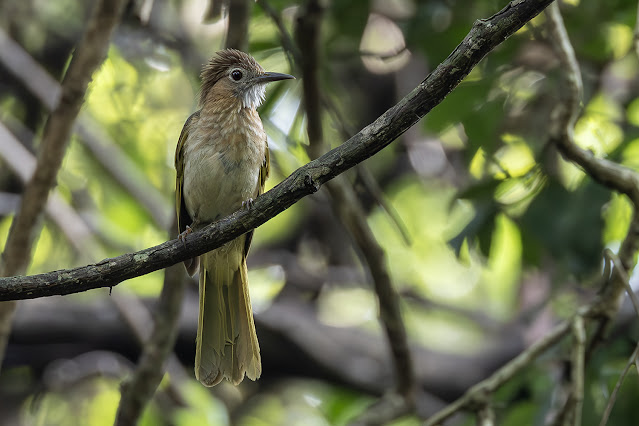It is that time of the year again, the quiet summer months when there are practically no interesting birds around. Every year I end up not going out as much as I should, as the weather is either too hot, or too wet, and all the effort often amount to very little. To be fair, our local forest birds are not that boring, and they provide some challenge for photography, even some of our common species can be tough to get a good photo of. One such example is the Streak-breasted Scimitar-Babbler, not a particularly rare species but is often very difficult to get a good photo of, even when they do show themselves it often gives you no more than a few seconds to take a photo. I got lucky the other day with this very vocal individual which basically perched there for a good few minutes, I love the way they hunch their back and puff up their neck to call.
 |
| Streak-breasted Scimitar-Babbler |
The Rufous-capped Babbler is perhaps even more common than the former, but is almost just as difficult to get a good photo of, as they skulk around the undergrowth, often blocked by leaves or twigs. Although arguably they are far more numerous than the Scimitar-Babbler, so you get more chance for them.
 |
| Rufous-capped Babbler |
Velvet-fronted Nuthatch is another species I enjoy seeing whenever I go out, these energetic birds are always seen climbing up and down tree trunks searching for food. Often when you see the Velvet-fronted Nuthatch, Yellow-cheeked Tits are not far behind.
 |
| Velvet-fronted Nuthatch |
 |
| Yellow-cheeked Tit - male |
Many birds follow the feeding flocks, Fork-tailed Sunbirds and Speckled Piculets are often found amongst them, mixed in with Swinhoe's White-eyes, these smaller birds are not the most obvious amongst the flock, but you can pick them out by their unique behaviour, such as the sunbird hovering in midair, and the Speckled Piculet turning its body left and right while perched.
 |
| Fork-tailed Sunbird - female |
 |
| Speckled Piculet |
While Red-whiskered Bulbuls are clearly the most dominant bulbul species in Hong Kong, other forest bulbuls do quite well here, such as the Mountain Bulbul. Chestnut Bulbuls and Black Bulbuls were all seen lately, but none gave me a chance to photograph them.
 |
| Mountain Bulbul |
We now have two species from the genus Copsychus breeding in Hong Kong, first being the familiar Oriental Magpie Robin, second being the fairly recently established White-rumped Shama, which are now increasingly common in some parts of Hong Kong. This male was seen at Shek Kong Catchwater, now a hotspot for this species. I often pick up the Shama by their musical song first, compare to the Oriental Magpie Robins they are much more reclusive, preferring to stay well hidden.
 |
| Oriental Magpie Robin - juvenile |
 |
| White-rumped Shama - male |
While I always say I am not a butterfly person, I never say no to a good butterfly if there aren't any birds around. A lovely looking Common Rose gave good perched views for me, I don't see them perched that often, so it was nice to be able to appreciate all the details on the wings. The Common Bluebottle on the other hand rarely stay still even when feeding, you can still get a good photo of them if you crank up your shutterspeed.
 |
| Common Rose |
 |
| Common Bluebottle |
A few more not so common butterflies, such as this Fluffy Tit, a species that was quite rare even just a few years ago, now seems fairly widespread but still not a common sight. The Indian Awlking is another uncommon species, although I do see them from time to time, they don't often stop for a good photo. Finally, the best butterfly I managed to bump into lately is probably a Commander, they are considered fairly rare in Hong Kong, although I have seen them a few times before, this was probably the first time I was able to get a photo of one.
 |
| Fluffy Tit |
 |
| Indian Awlking |
 |
| Commander |
Finally, something with no wings, a Red Muntjac that I bumped into lately, it didn't provide the best view, but it was still wonderful to see one in the wild here in Hong Kong. A young baby Chinese Water Dragon round up some of my nature observations lately.
 |
| Red Muntjac |
 |
| Chinese Water Dragon |



















Nice selection of resident birds, Matt ! At least you've braved the elements once or twice !
ReplyDeleteThanks John, with recent bad weather its hard to go outside at all!
Delete